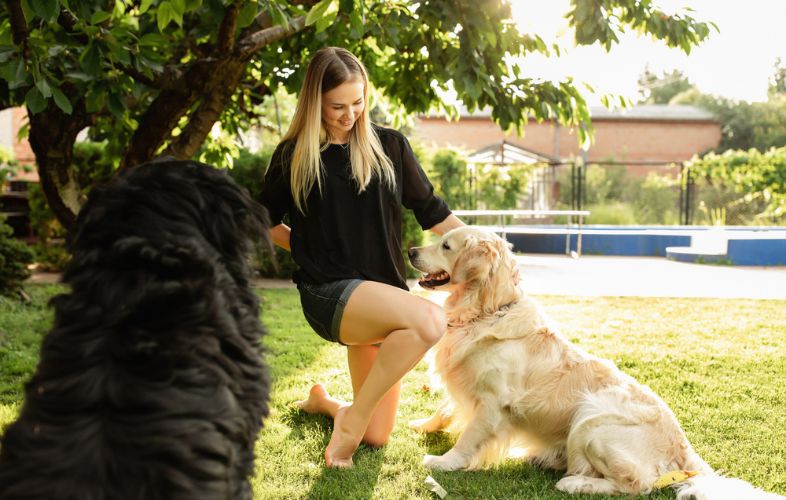Training a dog can be a rewarding experience, but it can also be quite challenging, especially when dealing with a stubborn canine companion. In this comprehensive guide, we’ll explore proven strategies and techniques to help you train a stubborn dog to obey commands effectively. Whether you’re dealing with a headstrong puppy or a mature dog with a mind of its own, these insights and methods will empower you to establish a harmonious and obedient relationship with your furry friend.
Understanding Canine Stubbornness
Before diving into training methods, it’s essential to understand why some dogs exhibit stubborn behavior. Dogs, like people, have distinct character traits. Factors such as breed traits, past experiences, and even your dog’s individual preferences can contribute to stubbornness. By acknowledging these factors, you can tailor your training approach to suit your dog’s specific needs.
Breed Traits and Stubbornness

Different dog breeds possess varying levels of stubbornness. Some breeds are naturally more independent and may require more patience during training. Knowing the breed features of your dog will help you understand his or her personality and behavior.
When it comes to training a dog, one size doesn’t fit all. Dogs, like people, have their own unique personalities and tendencies, and understanding these traits is essential to successful training. In this section, we’ll delve into the influence of breed traits on a dog’s stubbornness. Different breeds come with varying levels of independence and determination, and recognizing these breed-specific characteristics will help you tailor your training approach to better connect with your furry friend. Let’s explore how breed traits can play a significant role in understanding and addressing stubborn behavior in your dog.
Also Read: TOY DOG BREEDS
Past Experiences and Trauma
Dogs that have had negative experiences or trauma in the past may display stubborn behavior as a defense mechanism. Building trust and creating a positive training environment are essential when dealing with such dogs.
Individual Personality
Just like people, dogs have unique personalities. Some are eager to please, while others are more strong-willed. Recognizing your dog’s individual traits will help you tailor your training methods accordingly.
The Fundamentals of Training a Stubborn Dog

Training a stubborn dog requires a combination of patience, consistency, and positive reinforcement. Let’s delve into the fundamental principles that form the basis of successful dog training.
Establishing Clear Communication
Effective communication is key to any successful training regimen. Use clear and consistent verbal cues, hand signals, and body language to convey your expectations to your dog. Consistency in your commands and reactions will help your dog understand what you want.
Positive Reinforcement
Reward-based training is a powerful tool for encouraging desired behaviors. Whenever your dog follows a command or exhibits good behavior, reward them with treats, praise, or affection. Positive reinforcement creates a strong motivation for your dog to repeat the desired actions.
Patience and Persistence

Stubborn dogs may not grasp commands immediately, so patience is crucial. Try to keep your cool and your temper in check while training. Positive outcomes are the product of consistent practice over time.
Consistent Routine
Establish a consistent training routine with designated times for practice. Repetition and routine help reinforce the lessons and create a sense of structure for your dog.
When it comes to training our canine companions, one of the most crucial elements is consistency. Dogs thrive in an environment that offers structure and predictability. In this section, we’ll explore the importance of establishing a consistent routine in your dog’s life. Whether you’re a new dog owner or looking to improve your pet’s behavior, understanding the role of routine is the first step toward building a strong foundation for training and a harmonious life together.
Specific Training Techniques
Now, let’s explore specific training techniques that are particularly effective for stubborn dogs.
Clicker Training

Clicker training involves using a small handheld device that makes a clicking sound when pressed. Pairing the click with a treat helps dogs associate the click with good behavior. It’s an effective method for precise training.
Also Read: DOG BREEDS FOR FAMILIES WITH CHILDREN
Positive Association
Associate commands with positive experiences. For example, use treats or playtime as rewards for following commands. This creates a positive association with obeying your instructions.
Professional Training

Consider enrolling your dog in professional obedience dog training classes. Trainers have experience working with stubborn dogs and can provide valuable guidance and techniques.
Understanding how to use positive association effectively is a key skill for any dog owner or trainer. By the end of this section, you’ll have valuable insights into harnessing the positive power of association to achieve the best results in your dog’s training journey. Let’s dive in and discover how to make training an enjoyable and rewarding experience for your beloved canine companion.
Conclusion
Training a stubborn dog may present challenges, but with the right approach, it’s entirely achievable. By understanding your dog’s individuality, using positive reinforcement, and maintaining patience and consistency, you can transform your stubborn companion into an obedient and well-behaved member of your family. Remember that every dog is unique, so tailor your training methods to suit their specific needs. With dedication and love, you can build a strong bond and a happy, well-trained dog
FAQs
The time required for training varies depending on the dog’s age, temperament, and previous experiences. There are dogs that might act right away and dogs that might take longer. Keep going and be patient.
It’s never too late to train an older dog, but it may require more time and patience. Older dogs can still learn new behaviors with the right approach.

Leave a Reply